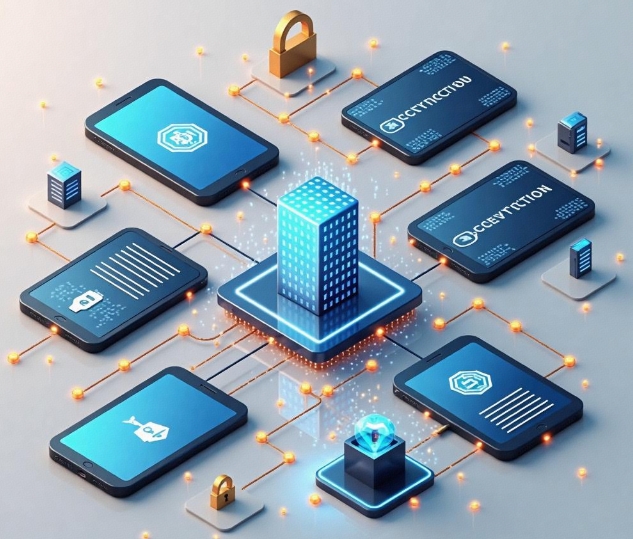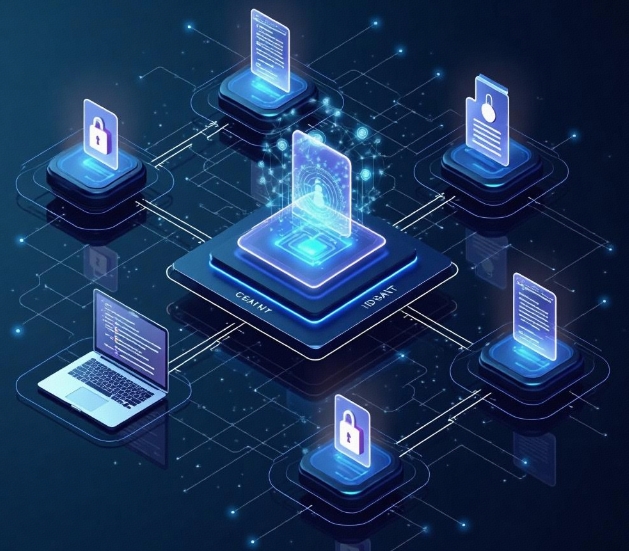Digital Identity and Authentication Technology in Blockchain Development
- latest articles
- 1.DApp Development & Customization: Merging Diverse Market Needs with User Experience 2.Analysis of the Core Technical System in DApp Project Development 3.How to achieve cross-chain interoperability in Web3 projects? 4.How does the tokenization of points reconstruct the e-commerce ecosystem? 5.How to Set and Track Data Metrics for a Points Mall? 6.What is DApp Development? Core Concepts and Technical Analysis 7.Inventory of commonly used Web3 development tools and usage tips 8.Development of a Distribution System Integrated with Social E-commerce 9.Six Key Steps for Businesses to Build a Points Mall System 10.What is DApp Development? A Comprehensive Guide from Concept to Implementation
- Popular Articles
- 1.Future Trends and Technology Predictions for APP Development in 2025 2.Analysis of the DeFi Ecosystem: How Developers Can Participate in Decentralized Finance Innovation 3.From Zero to One: How PI Mall Revolutionizes the Traditional E-commerce Model 4.DAPP Development | Best Practices for Professional Customization and Rapid Launch 5.Recommended by the Web3 developer community: the most noteworthy forums and resources 6.From Cloud Computing to Computing Power Leasing: Building a Flexible and Scalable Computing Resource Platform 7.How to Develop a Successful Douyin Mini Program: Technical Architecture and Best Practices 8.Shared Bike System APP: The Convenient Choice in the Era of Smart Travel 9.How to Create a Successful Dating App: From Needs Analysis to User Experience Design 10.From Design to Development: The Complete Process of Bringing an APP Idea to Life
With the rapid development of blockchain technology, its applications across various fields are gradually expanding, especially in digital identity and authentication technologies, where blockchain demonstrates its unique advantages. Digital identity refers to the digital information that represents an individual or organization in the digital environment, while authentication technology involves a series of methods to verify the authenticity of that identity. Combined with the decentralized, tamper-proof characteristics of blockchain, digital identity and authentication technologies are becoming increasingly important in modern society. This article will delve into digital identity and authentication technologies in blockchain development, including their definitions, working principles, application scenarios, and future trends.
I. Background of Digital Identity and Authentication Technologies
1.1 Definition and Importance of Digital Identity
Digital identity refers to the electronic identity representation of an individual or organization on the internet, including basic information such as name, date of birth, address, and contact details, as well as behavioral data and consumption habits obtained through social media, online platforms, etc. In an information-driven society, digital identities are almost ubiquitous, spanning industries like finance, healthcare, education, and government services. Therefore, ensuring the authenticity and security of these digital identities has become an urgent issue to address.
1.2 The Necessity of Authentication Technology
Authentication technology aims to confirm whether a user's digital identity is genuine and trustworthy, typically through methods such as passwords, biometrics, and dynamic verification codes. Traditional authentication methods, like usernames and passwords, are vulnerable to cracking and leakage, making it difficult to meet the growing security demands. In contrast, blockchain-based authentication technology addresses the security risks of traditional methods through decentralized mechanisms, providing new safeguards for the security of digital identities.

II. Integration of Blockchain and Digital Identity Authentication
2.1 Basic Concepts of Blockchain
Blockchain is a decentralized distributed ledger technology capable of recording and storing tamper-proof transaction data. Each "block" in the blockchain contains a series of verified transaction data, and these blocks are linked together through cryptographic algorithms to form a complete data structure. The key features of blockchain technology include decentralization, immutability, transparency, and security, which give it inherent advantages in digital identity authentication.
2.2 Applications of Blockchain in Digital Identity
By storing digital identity information on the blockchain, some issues in traditional digital identity management can be effectively resolved. Blockchain technology makes digital identity management more transparent and tamper-proof, while also providing better protection for user data privacy.
On the blockchain, digital identities can exist in the form of "Decentralized Identifiers (DID)." DID is a new type of identity authentication method under blockchain technology that does not rely on any centralized identity verification authority. Instead, it uses technologies like smart contracts and cryptographic algorithms to ensure the security and reliability of identity information. Through DIDs, users can fully control their identity data, avoiding the risks of privacy leaks and identity theft present in traditional authentication methods.
2.3 Innovations in Authentication Technology
The application of blockchain in authentication technology is mainly reflected in the following aspects:
Decentralized Authentication: Traditional authentication relies on centralized institutions like banks and governments, whereas blockchain eliminates intermediaries, making the authentication process more transparent, efficient, and cost-effective.
Privacy Protection: Through encryption technology, blockchain can verify identities while ensuring that users' private information is not leaked or tampered with.
Enhanced Security: Due to the immutability of blockchain data, any attempt to modify digital identity information is recorded, significantly improving the security of identity authentication.
III. Application Scenarios of Blockchain in Digital Identity Authentication
3.1 Financial Sector
In the financial sector, digital identity authentication is widely used in scenarios such as bank account opening, online payments, and loan applications. Through blockchain technology, financial institutions can ensure the authenticity of customer identity information and reduce the risk of identity theft through decentralized identity verification. For example, some banks have started using blockchain-based digital identity authentication systems, verifying users' identities during account opening through biometrics and smart contracts to ensure the security and efficiency of the process.
3.2 Healthcare Sector
In the healthcare industry, digital identity authentication technology is also widely applied. Sensitive information such as patients' health data and diagnostic records requires strict protection. Through blockchain, medical institutions can ensure that patient identity information is not tampered with or leaked, enhancing the security of medical data exchange. Additionally, patients can use blockchain to control access to their health data, allowing only authorized doctors or hospitals to view their health records, thereby strengthening patients' control over their personal privacy.
3.3 E-Government and Public Services
In the fields of e-government and public services, digital identity authentication technology helps governments improve the efficiency and security of public services. Blockchain can be used for citizen identity authentication and management, reducing instances of forgery and identity theft. For example, some countries have begun researching the use of blockchain for issuing electronic IDs, ensuring the security and credibility of citizen identity information. Additionally, blockchain can streamline the processing of public affairs such as taxation and social security, enhancing administrative efficiency.

IV. Challenges and Prospects of Blockchain Digital Identity and Authentication Technology
4.1 Challenges
Although blockchain has many advantages in digital identity and authentication technologies, it still faces some challenges in practical applications:
Technical Standardization Issues: Currently, the application of blockchain in digital identity authentication has not yet achieved full standardization, and interoperability between different blockchain platforms is poor, which may affect cross-platform identity authentication.
User Acceptance: Acceptance of blockchain technology remains relatively low, and many users are still unfamiliar with the concept of decentralized identity verification, potentially leading to resistance to new technologies.
Privacy Protection Issues: Although blockchain itself has strong security features, balancing privacy protection with the transparency of identity authentication in a decentralized environment remains a challenge.
4.2 Future Development Prospects
With the continuous development of technology, the application prospects of blockchain in digital identity and authentication technologies are very broad. In the future, blockchain technology will gradually mature and address existing technical bottlenecks, achieving significant progress in areas such as data privacy protection and cross-platform interoperability. Additionally, as societal demand for digital identity authentication increases, blockchain technology will further transform identity authentication methods in industries like finance, healthcare, and government services, driving society toward a more secure and efficient digital era.
Conclusion
The application of blockchain technology in digital identity and authentication technologies is continuously evolving and improving. Its decentralized and tamper-proof characteristics provide innovative solutions for the management and authentication of digital identities. Although challenges related to technology and privacy protection remain, with ongoing technological advancements and increasing societal emphasis on digital identity security, blockchain will play a crucial role in the future of digital identity management and authentication, providing strong support for the digital transformation of various industries.
-

How to achieve cross-chain interoperability in Web3 projects?
With the continuous development of WEB3 technology, Web3 has gradually become an···
-

Inventory of commonly used Web3 development tools and usage tips
With the continuous development of blockchain technology, Web3 has become a hot ···
-

Web3 development trend prediction: analysis of future technology directions and application scenarios
With the gradual development of blockchain technology, the concept of Web3 has m···

 Blockchain
Blockchain










